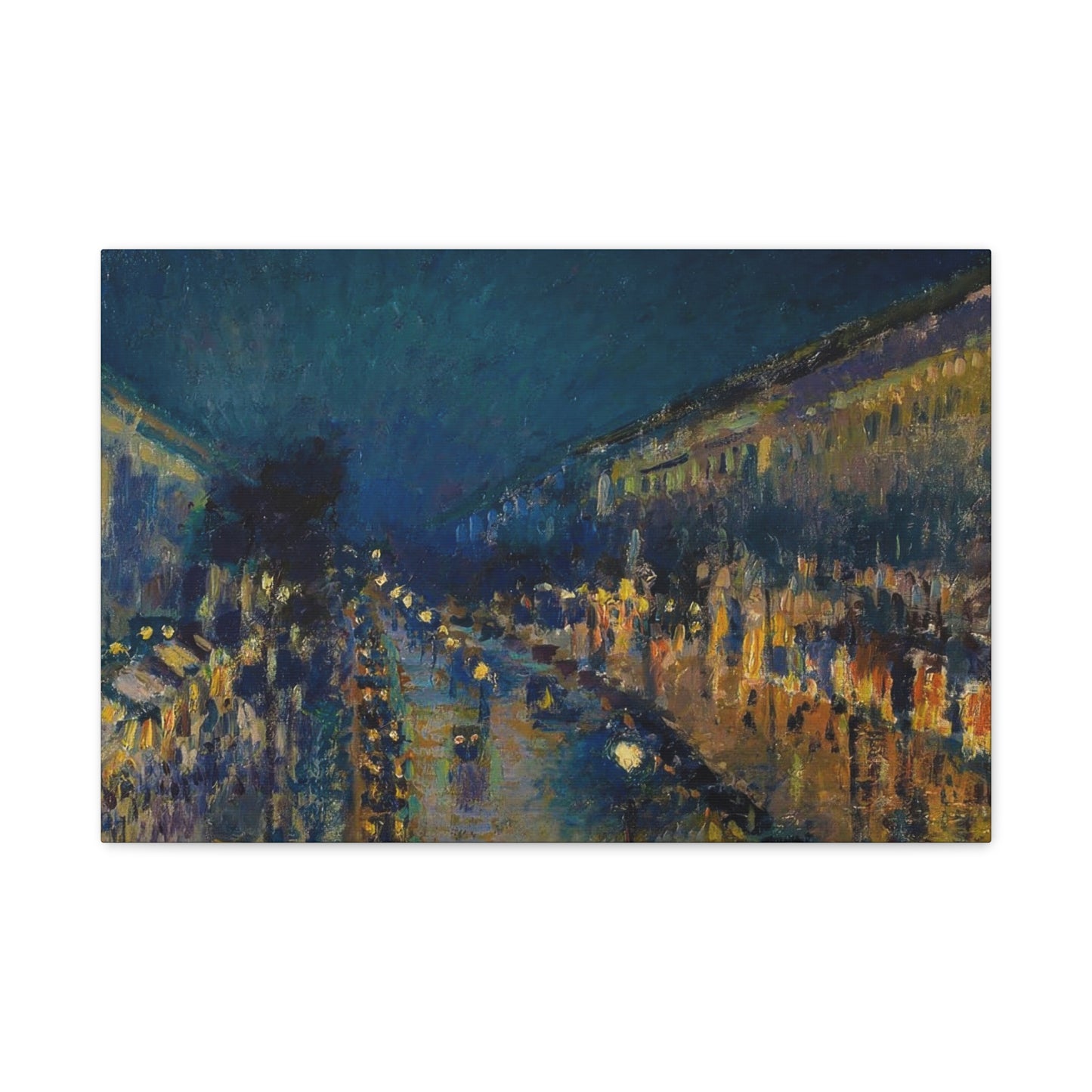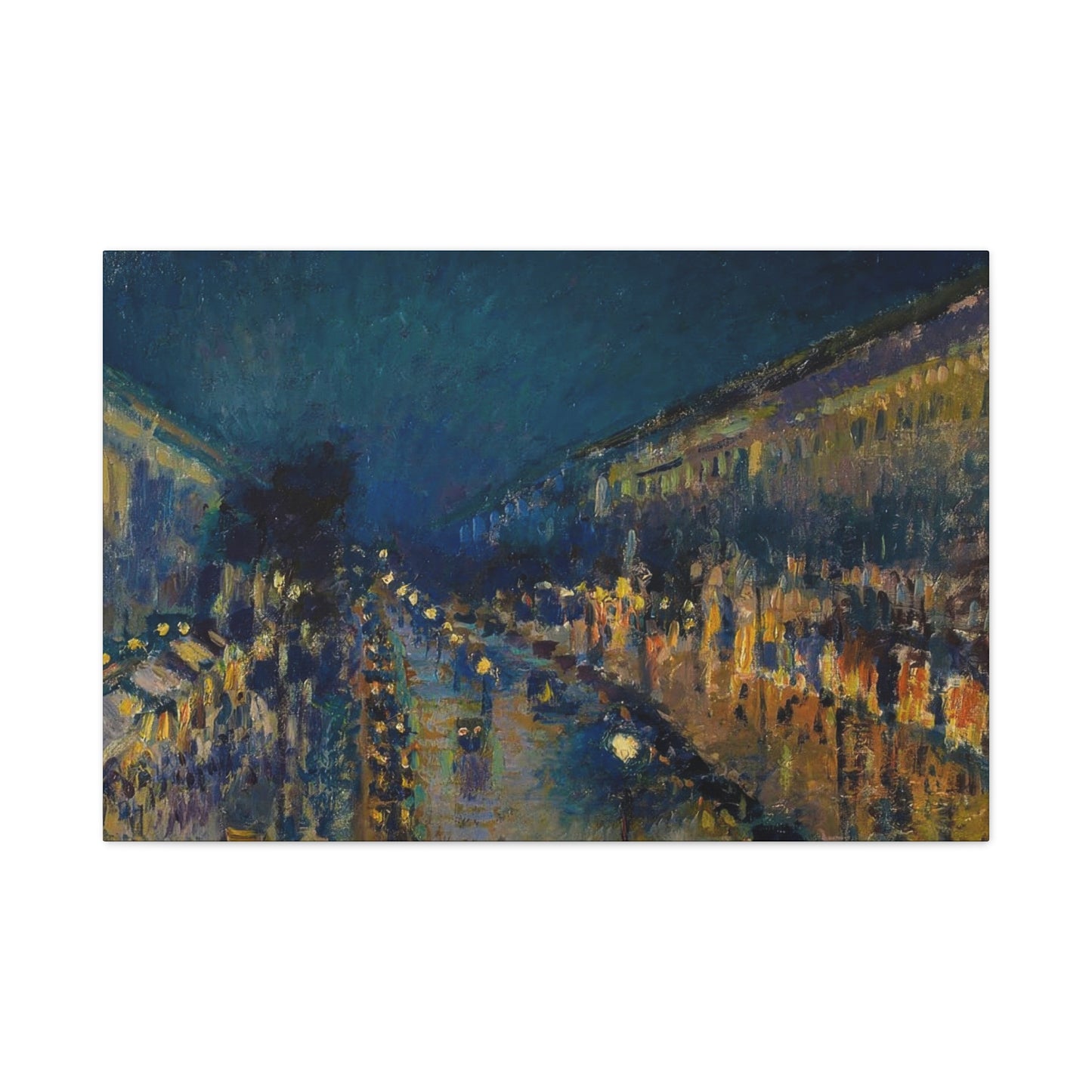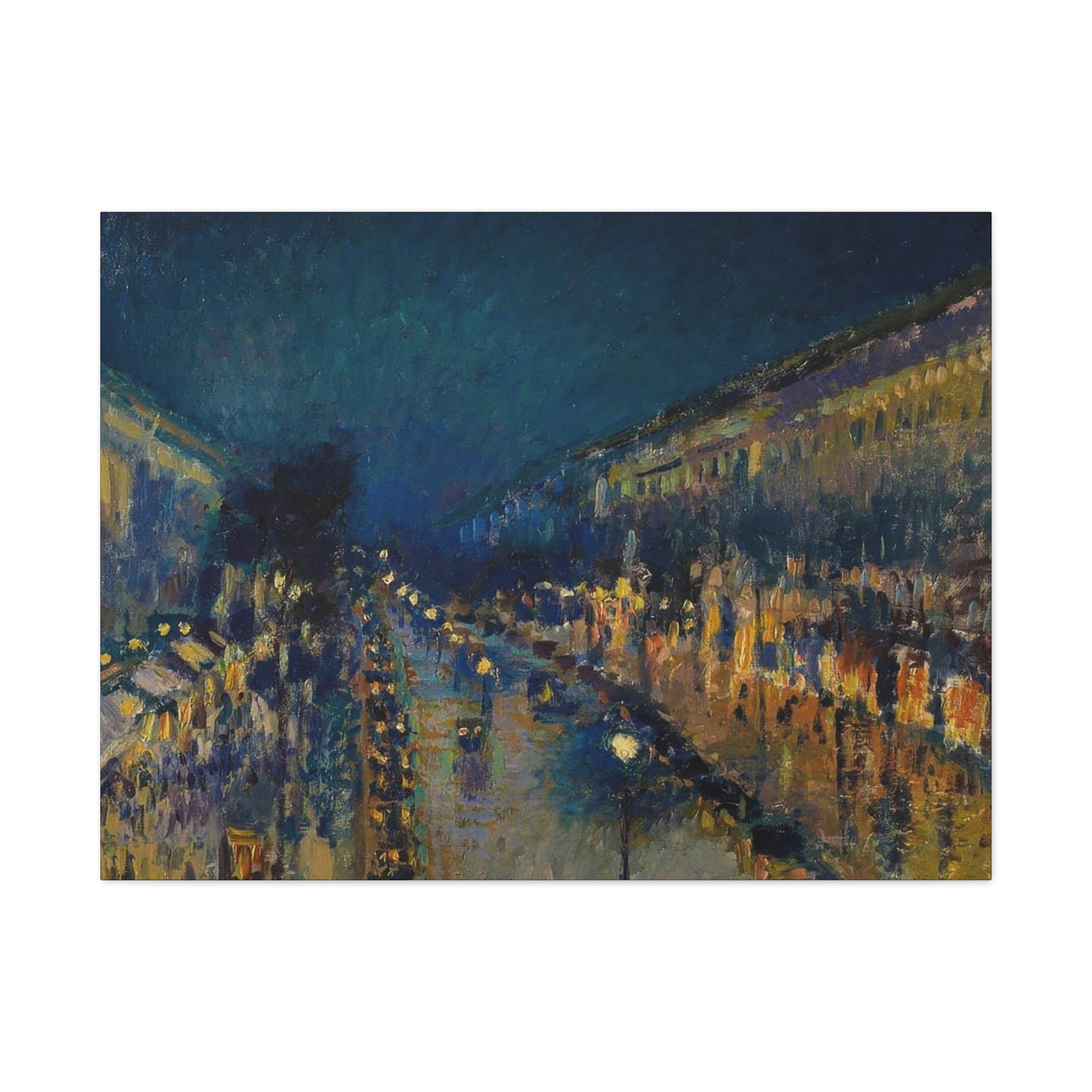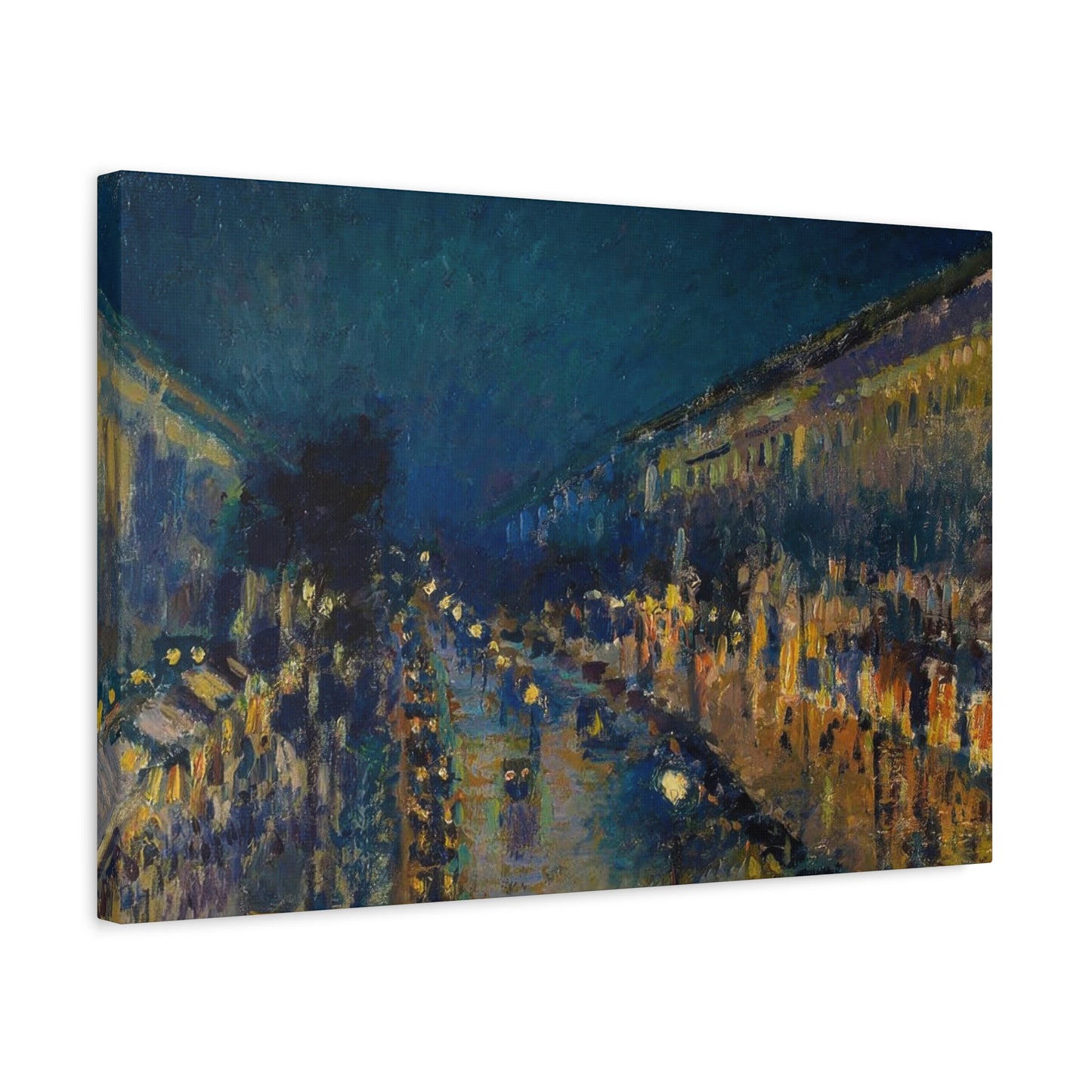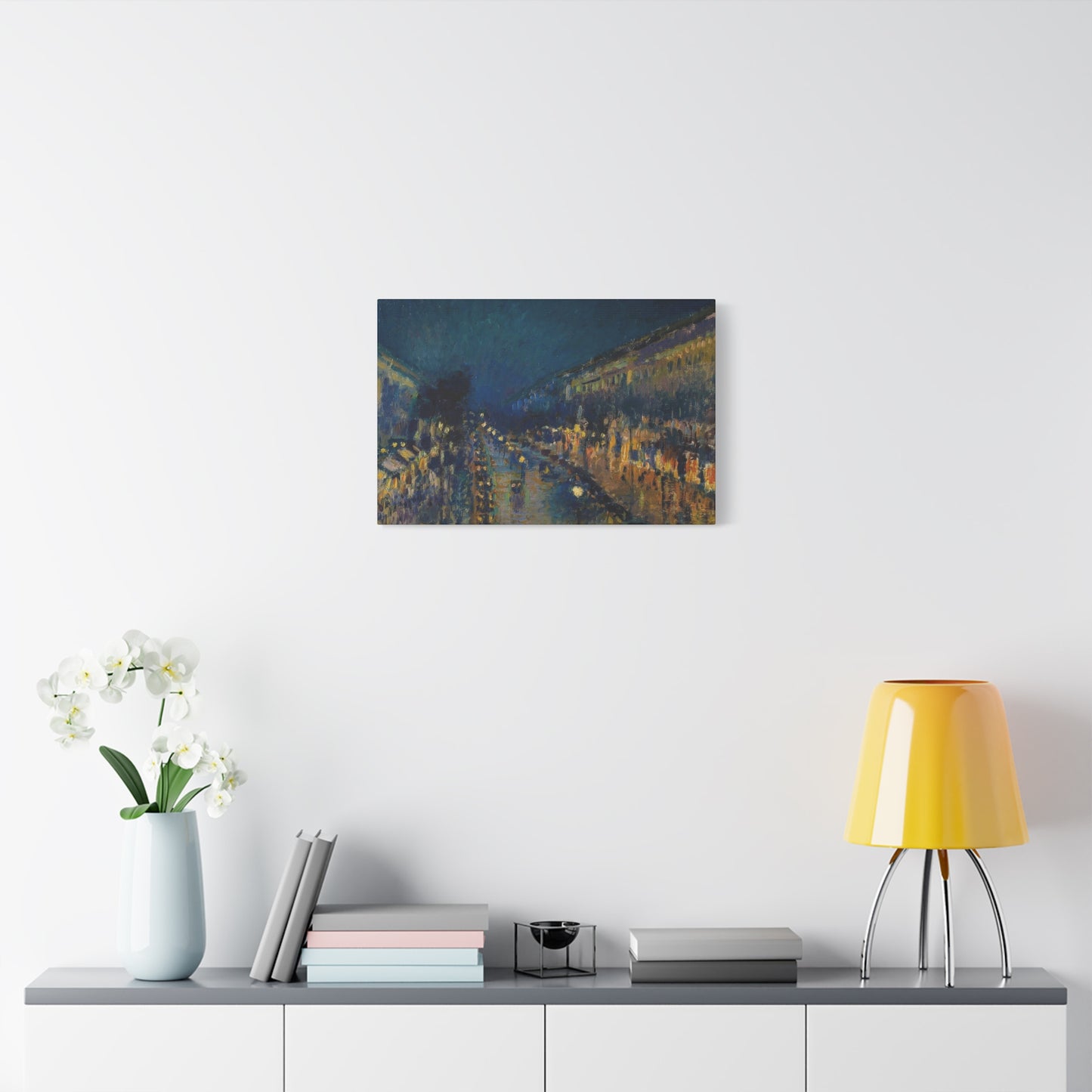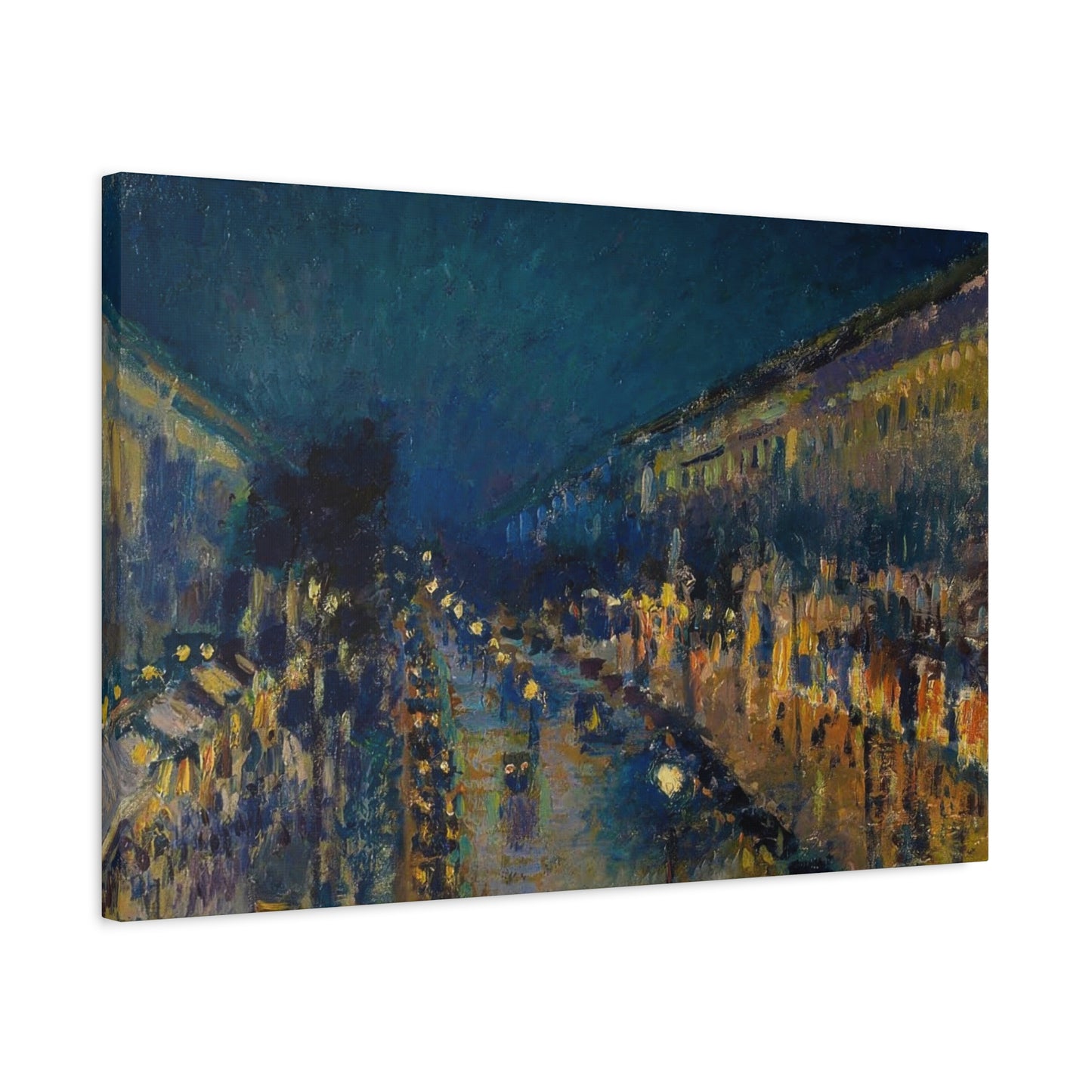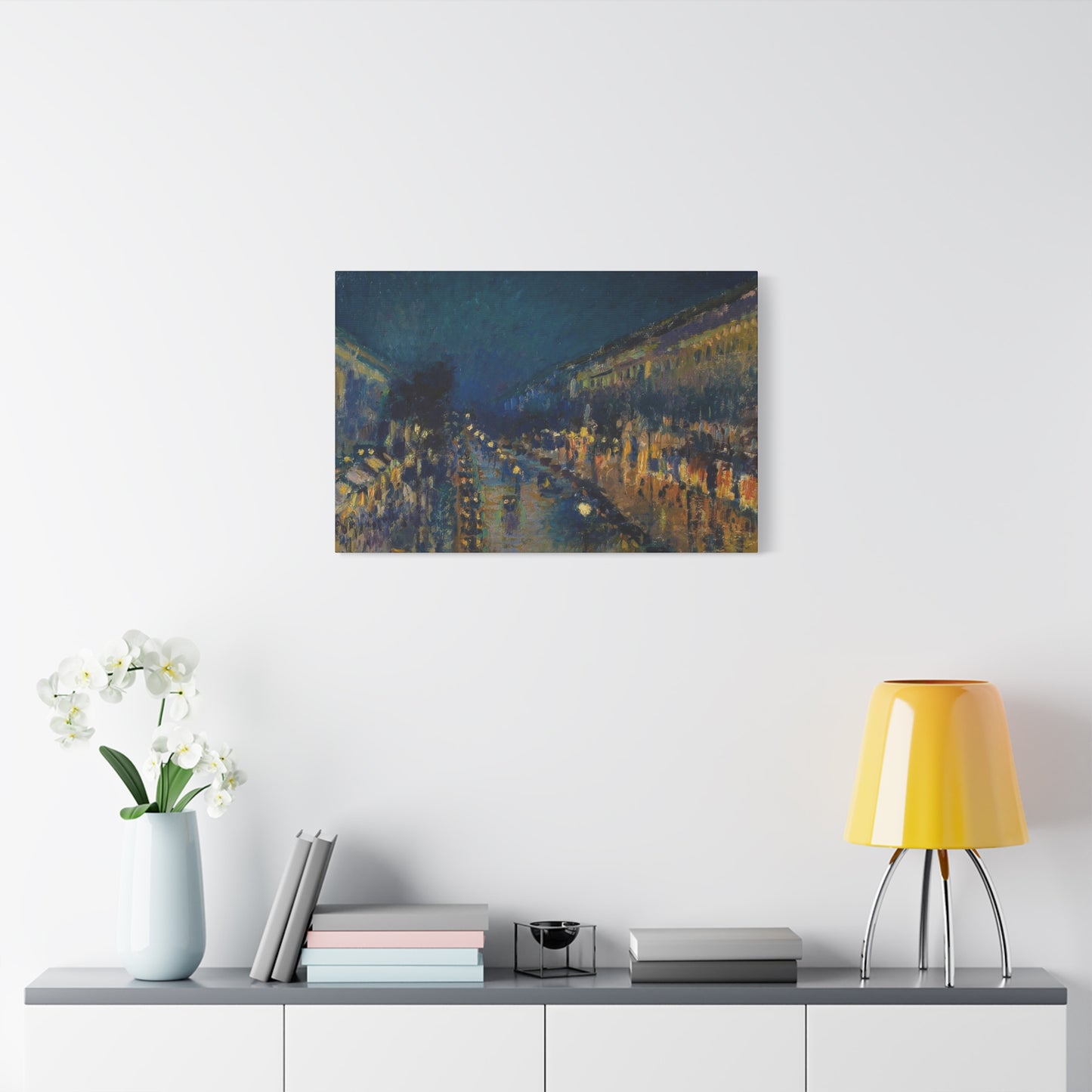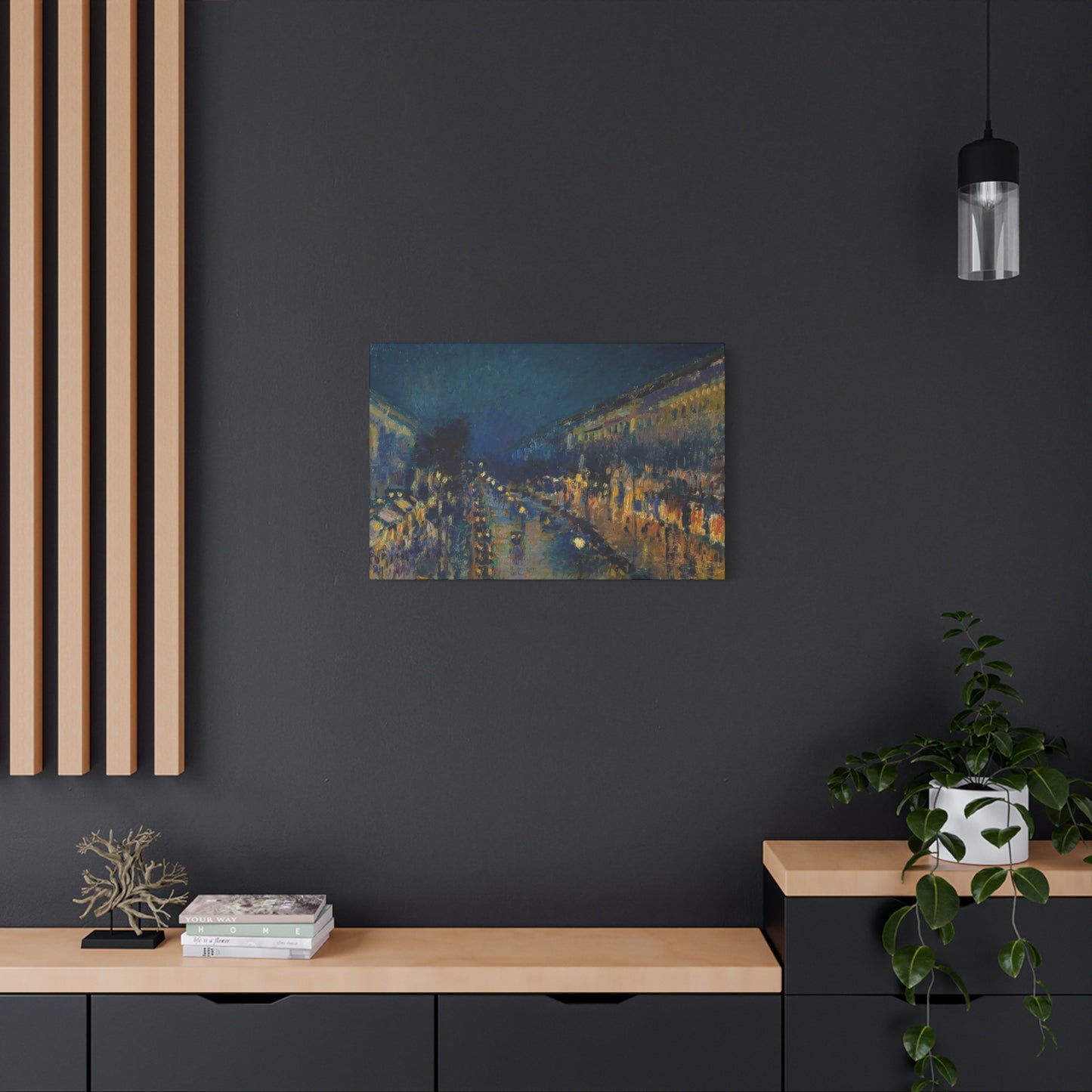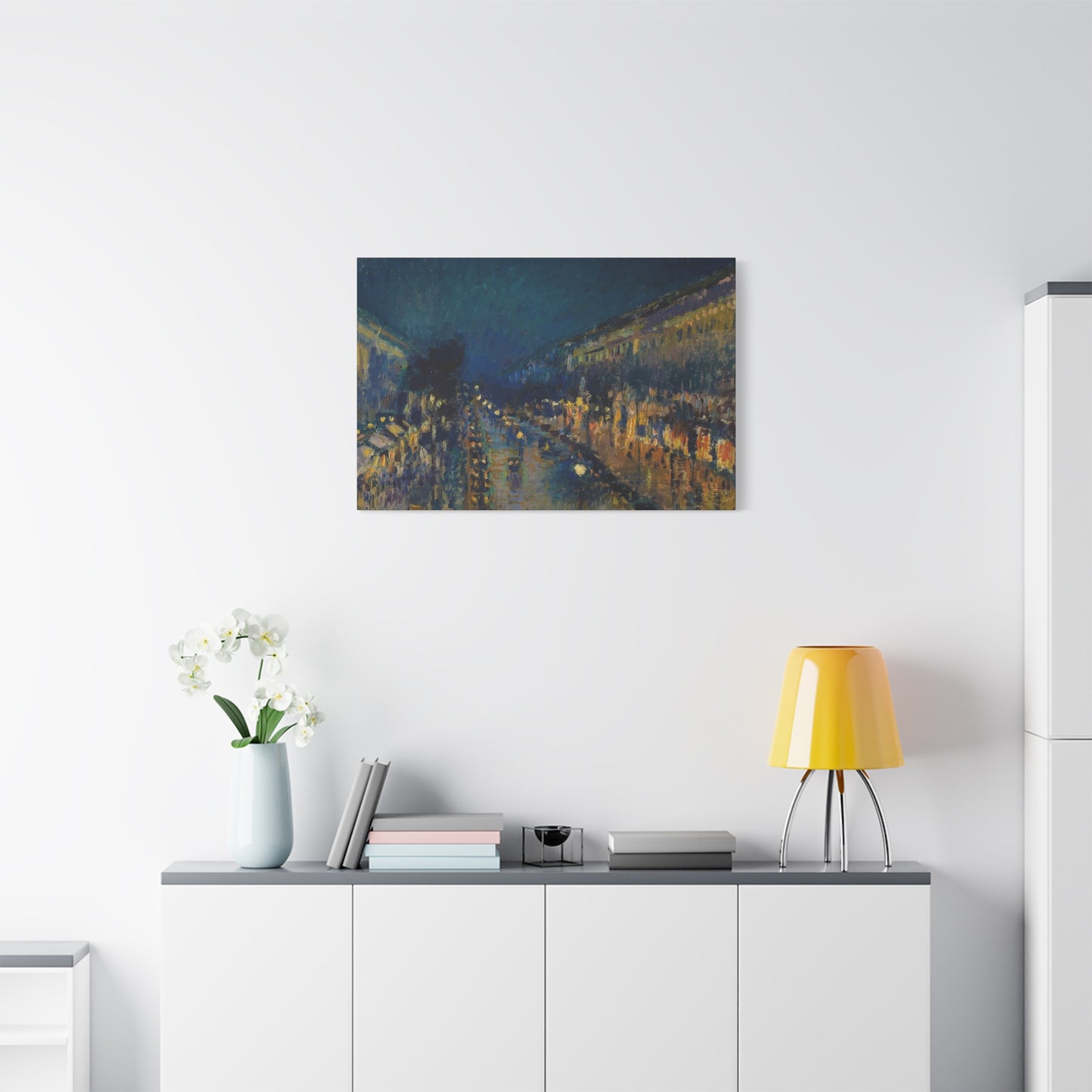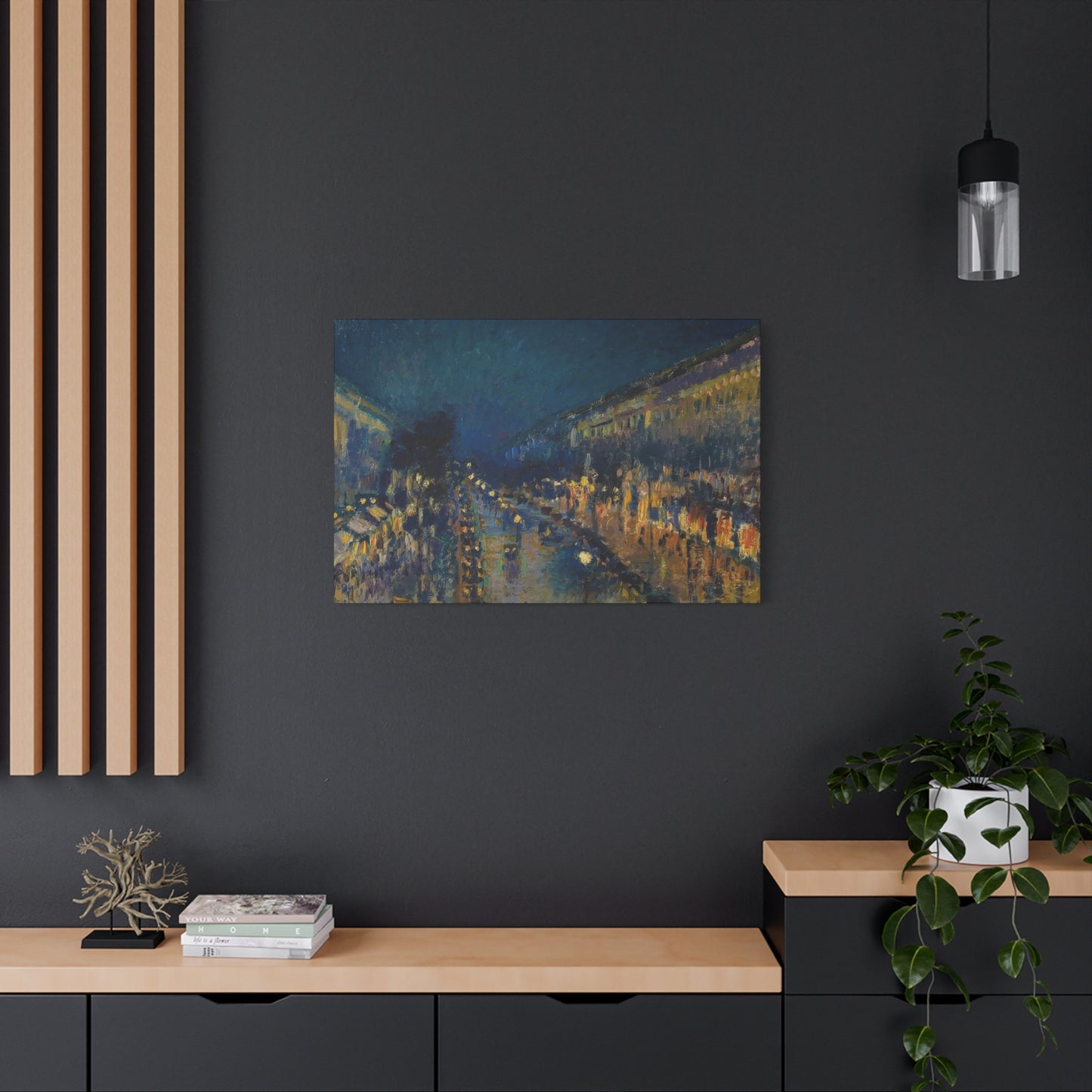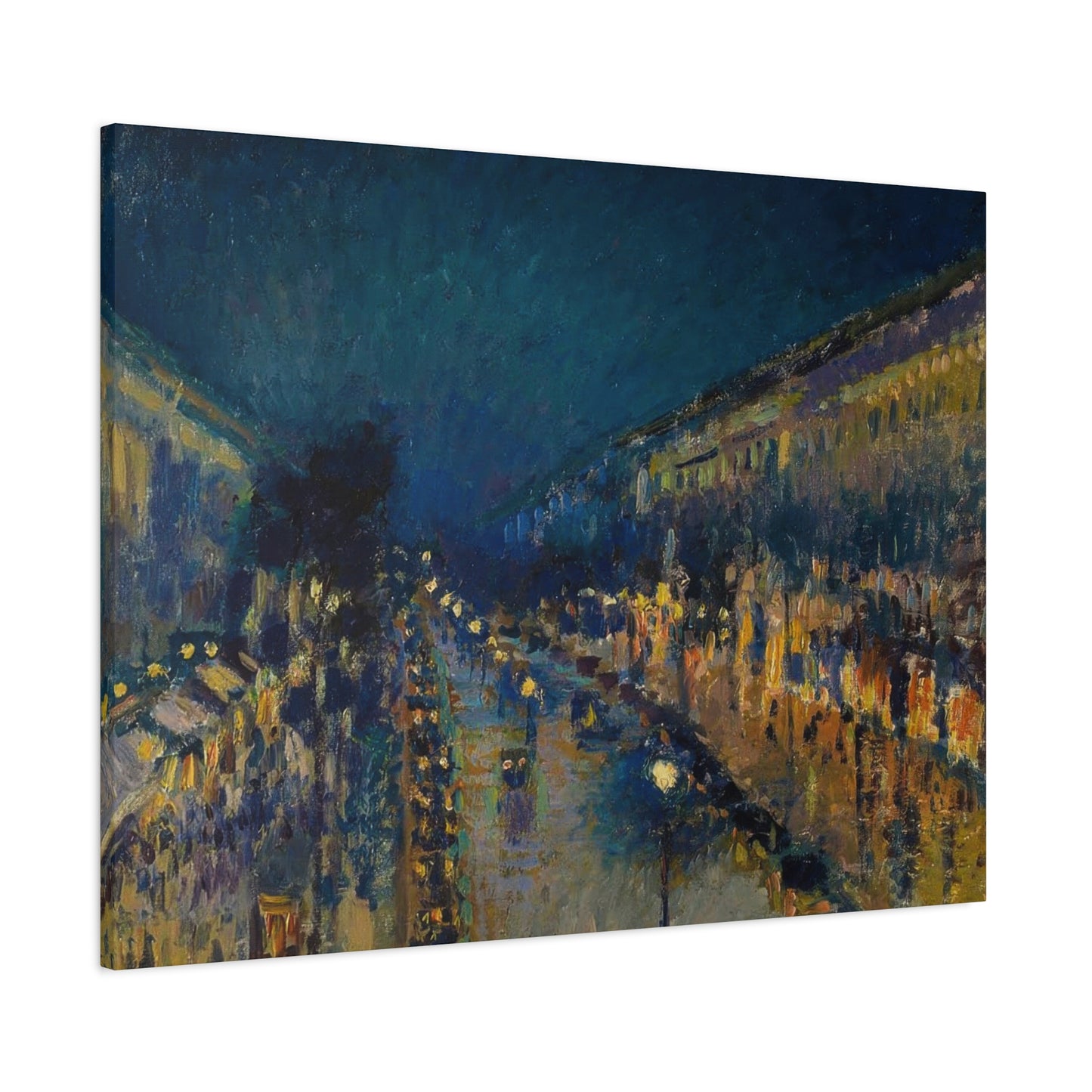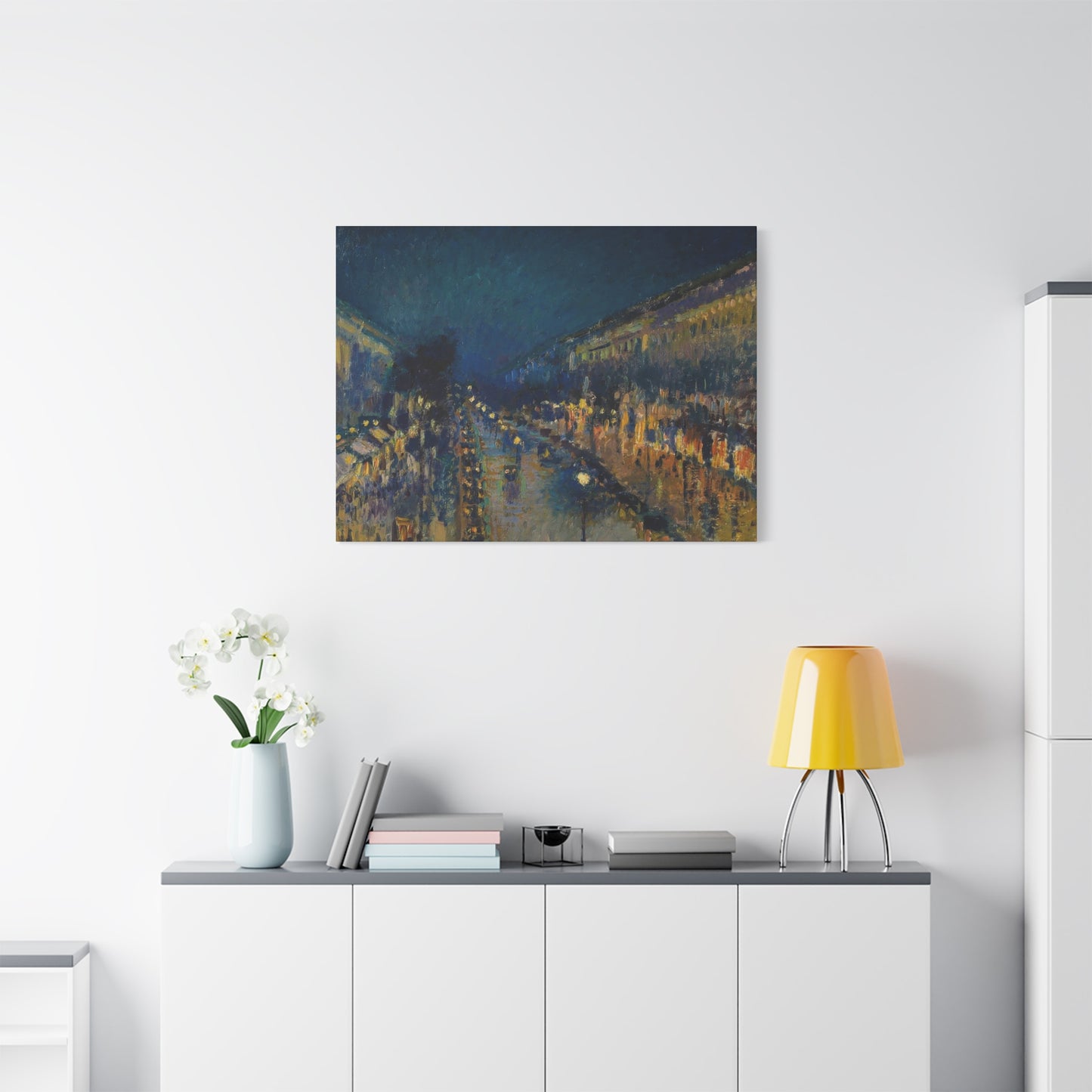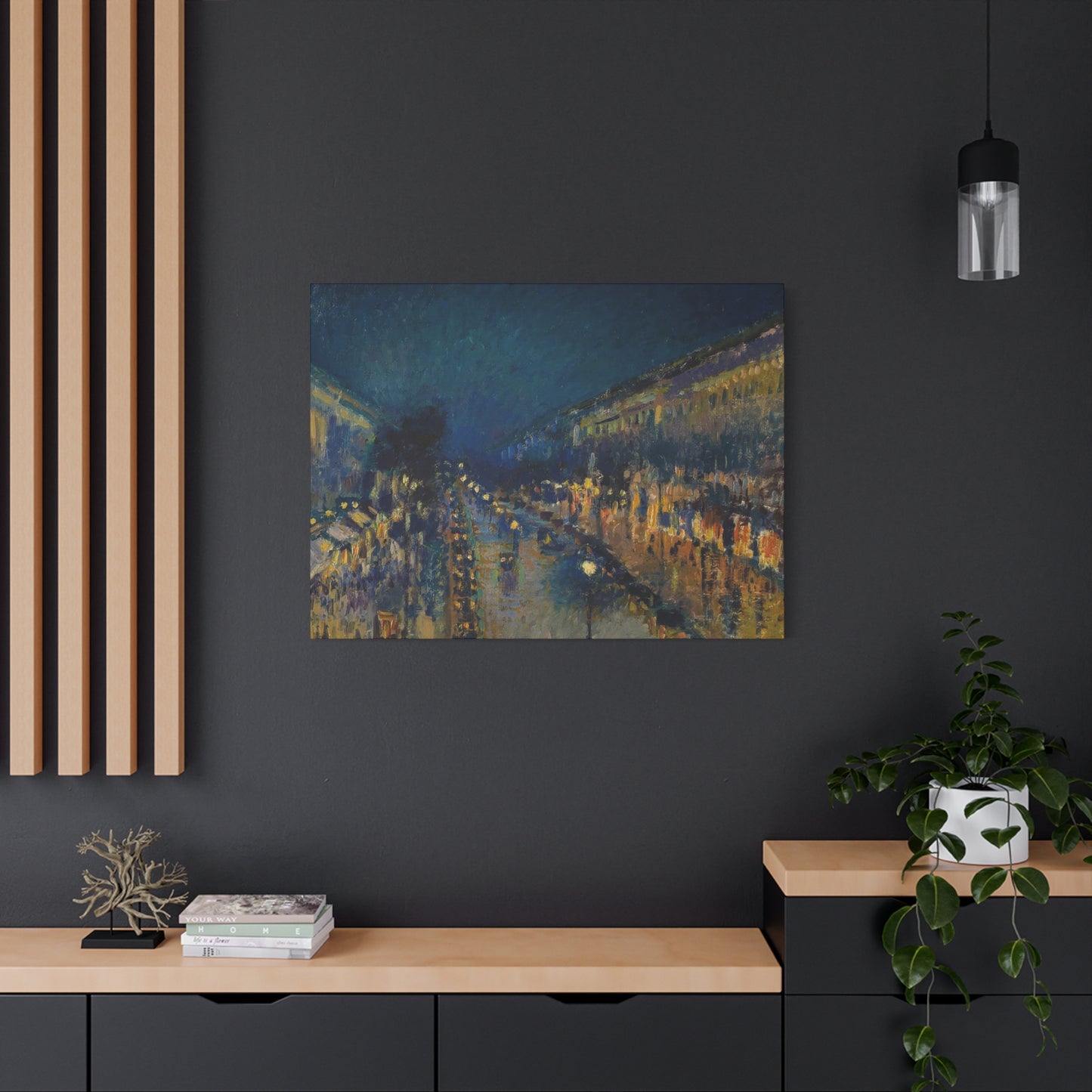Boulevard Montmartre at Night Impression Wall Art: A Complete Guide to Parisian Nocturnal Masterpieces
The enchanting allure of Parisian nightscapes has captivated art enthusiasts for generations, and few subjects embody this romantic vision more profoundly than the Boulevard Montmartre illuminated by evening lights. This comprehensive exploration delves into the magnificent world of nocturnal impressionist artwork, specifically focusing on canvas reproductions that bring the magic of nineteenth-century Paris into contemporary living spaces. The transformation of this iconic Parisian boulevard into wall art represents not merely a decorative choice but a connection to artistic heritage that continues to resonate with modern sensibilities.
Impressionist painters revolutionized how we perceive urban landscapes, and their nocturnal compositions offer viewers a glimpse into the atmospheric beauty of historic Paris. When translated onto canvas prints, these masterpieces become accessible treasures that allow anyone to experience the luminous quality and emotional depth of original impressionist works. The interplay of artificial light against darkened skies, the bustling energy of evening crowds, and the distinctive architectural character of Montmartre combine to create images that transcend mere representation, offering instead an emotional experience of a moment frozen in time.
Contemporary reproductions utilizing modern printing technology have made it possible to capture the nuanced brushwork and subtle color gradations that define impressionist technique. The textured surface of quality canvas enhances the visual authenticity of these reproductions, creating an experience that honors the original artistic intent while providing durability and affordability. Whether displayed in residential settings, commercial spaces, or cultural institutions, these nocturnal Parisian scenes continue to evoke wonder and contemplation among viewers who appreciate the intersection of historical significance and aesthetic beauty.
The Historical Significance of Montmartre Boulevard in Impressionist Art
The Boulevard Montmartre holds a distinguished position within the pantheon of impressionist subjects, representing a microcosm of Parisian urban life during a transformative period in European history. This thoroughfare, situated in the ninth arrondissement of Paris, became a favored subject for artists seeking to capture the dynamic energy of modern city life. The area's transformation from a semi-rural district to a bustling commercial and entertainment center paralleled the broader modernization of Paris under Baron Haussmann's ambitious urban renewal projects.
Impressionist painters were drawn to this location for multiple compelling reasons. The boulevard's wide expanse provided an ideal vantage point for observing the flow of pedestrian and vehicular traffic, while the presence of theaters, cafes, and shops generated constant human activity that animated the scene. The architectural uniformity imposed by Haussmann's regulations created a visual rhythm that painters could exploit compositionally, using repetitive building facades as structural elements within their compositions.
The decision to paint this boulevard at night introduced additional layers of complexity and interest to the subject matter. Evening illumination transformed familiar daytime scenes into mysterious, atmospheric environments where artificial light sources created dramatic contrasts and unusual color effects. Gas lamps and shop windows cast warm pools of light onto wet pavement surfaces, generating reflections that doubled the visual interest of the composition. These lighting conditions challenged painters to develop new technical approaches for representing luminosity and atmosphere.
During the late nineteenth century, Montmartre boulevard epitomized the modern Parisian experience. The district's theaters presented popular entertainments, attracting crowds from across the city and creating a vibrant nightlife culture. This social dynamism made the location particularly appealing to impressionist painters who sought to document contemporary life rather than historical or mythological subjects. The presence of diverse social classes mingling on the boulevard provided opportunities for observing human behavior in its natural urban habitat.
The artistic community's fascination with this particular location also reflected broader cultural shifts occurring throughout European society. The expansion of electric and gas lighting extended the hours during which public spaces remained active and accessible, fundamentally altering urban social patterns. Artists recognized that these technological innovations were creating entirely new visual experiences worthy of documentation and interpretation through painting.
Several prominent impressionist painters created multiple versions of boulevard scenes, returning repeatedly to favorite locations under varying weather conditions and times of day. This serial approach allowed them to explore how changing atmospheric conditions affected the appearance of familiar subjects. Nocturnal versions presented particular challenges, requiring artists to develop specialized techniques for rendering artificial light sources and their effects on surrounding surfaces and atmospheric conditions.
The historical documentation provided by these paintings offers contemporary viewers invaluable insights into nineteenth-century urban life. Details of architecture, costume, transportation methods, and commercial signage visible in these works serve as visual historical records that complement written accounts from the period. Beyond their documentary value, however, these paintings succeed primarily as artistic achievements that transcend their specific historical moment through their formal qualities and emotional resonance.
Understanding the Impressionist Night Scene Painting Technique
Impressionist approaches to nocturnal painting required significant technical innovation and departure from academic traditions. Conventional academic training emphasized carefully controlled studio lighting and precise drawing as foundational skills. Impressionists working outdoors at night confronted entirely different challenges that demanded new solutions. The reduced overall light levels made direct observation more difficult, while artificial light sources created unusual color temperatures and dramatic value contrasts that contradicted traditional modeling techniques.
The color palette employed in nocturnal impressionist works differs substantially from that used in daylight scenes. Rather than relying on the bright, saturated hues characteristic of sunlit landscapes, night scenes incorporate deeper tones and more complex color mixtures. Blues, purples, and deep greens dominate shadow areas, while artificial light sources introduce warm oranges, yellows, and creams that create striking complementary contrasts. These color relationships generate visual excitement and convey the specific quality of gaslight or early electric illumination.
Brushwork in nocturnal impressionist paintings often becomes looser and more suggestive than in daylight compositions. The reduced visibility of fine details in actual night scenes justified a more abbreviated handling of paint that captured essential forms without laboring over minutiae. This technical approach aligned perfectly with impressionist philosophy, which prioritized conveying an immediate sensory impression over achieving photographic accuracy. Visible brushstrokes contribute to the sense of spontaneity and directness that characterizes successful impressionist work.
The challenge of representing luminous light sources within a painting requires careful consideration of relative values. Painters discovered that achieving the sensation of brightness depends less on using pure white pigment than on controlling the values of surrounding areas. By keeping adjacent areas sufficiently dark, even moderate tones can read as brilliantly illuminated. This principle of relative value became essential for creating convincing nocturnal effects without resorting to harsh, unmodulated light passages.
Atmospheric perspective operates differently in night scenes compared to daylight conditions. While distant objects in daylight typically appear cooler and lighter in value, nighttime atmospheric effects vary depending on artificial light distribution. Areas beyond the reach of street lighting might recede into near-complete darkness, while illuminated zones maintain visibility regardless of distance. Impressionist painters exploited these effects to create spatial depth while maintaining the overall unity of their nocturnal compositions.
The wet pavement surfaces frequently depicted in these boulevard scenes provided opportunities for complex reflective effects. Rain-slicked cobblestones mirror light sources, effectively doubling their visual presence within the composition while also contributing additional colors and textures. These reflections create vertical elements that balance the horizontal thrust of the boulevard's perspective, adding compositional interest while reinforcing the atmospheric qualities that define the scene.
Impressionist painters working at night often employed memory and rapid notation techniques to capture fleeting effects. The practical difficulties of painting in darkness with limited visibility meant that complete works were frequently finished in the studio based on preliminary outdoor studies. This working method required artists to develop strong visual memory skills and the ability to recreate observed atmospheric effects from sketchy notations and color studies.
The technical innovations developed by impressionists for rendering nocturnal scenes influenced subsequent artistic movements and continue to inform contemporary painting practice. Their discoveries regarding color temperature relationships, the representation of artificial light, and atmospheric effects in reduced illumination have become fundamental principles taught in art schools worldwide. Understanding these technical aspects enhances appreciation for the skill and observation that produced these enduring masterpieces.
The Emotional and Atmospheric Qualities of Parisian Night Scenes
Nocturnal depictions of Parisian boulevards communicate emotional content that extends beyond mere visual description. The specific atmospheric qualities of evening light create moods ranging from romantic warmth to mysterious ambiguity, depending on weather conditions and the artist's interpretive approach. These emotional dimensions contribute significantly to the enduring appeal of such imagery and explain why they continue to resonate with contemporary audiences despite depicting scenes from over a century ago.
The interplay between illumination and darkness generates a sense of drama absent from daytime scenes. Pools of warm light emanating from shop windows and street lamps create welcoming zones of visibility within the surrounding darkness, suggesting safety, commerce, and social interaction. This contrast between light and shadow metaphorically represents broader themes of civilization versus nature, order versus chaos, and human community versus isolation. Viewers respond to these archetypal contrasts on both conscious and unconscious levels.
Weather conditions add additional layers of atmospheric effect to nocturnal boulevard scenes. Mist and rain diffuse light sources, creating glowing halos and softening architectural details into suggestive forms. These conditions enhance the dreamlike, almost magical quality of the scene, transforming a straightforward urban view into something more poetic and evocative. The temporal specificity of such atmospheric effects reminds viewers that these paintings capture unique, unrepeatable moments rather than generic city views.
The human activity depicted in these scenes contributes significantly to their emotional content. Evening crowds gathering for entertainment, couples strolling together, and individuals hurrying to unknown destinations all suggest narratives that viewers can imagine and expand upon. The impressionist technique of indicating figures with minimal detail paradoxically makes them more universal and relatable, allowing viewers to project their own experiences and emotions onto these anonymous city dwellers.
Color relationships in nocturnal scenes evoke specific emotional responses based on both cultural associations and psychological effects. Warm tones from artificial lighting suggest comfort, sociability, and human presence, while cooler atmospheric blues and purples convey the natural environment and the passage from day to night. The juxtaposition of these contrasting color temperatures creates visual tension that keeps the composition dynamic and engaging while reinforcing the transitional quality of the evening hour.
The temporal quality of these nocturnal scenes resonates with universal human experiences of daily rhythms and cycles. Evening represents a transition from work to leisure, from public to private life, and from rational daylight consciousness to the more intuitive, emotional realm associated with darkness. Paintings that capture this liminal time period tap into deeply rooted psychological patterns and cultural meanings associated with the day's end and the beginning of night.
The architectural environment of nineteenth-century Paris visible in these paintings contributes to their emotional impact through associations with romance, culture, and European sophistication. For viewers worldwide, Parisian streetscapes evoke idealized notions of urban elegance, artistic creativity, and refined leisure activities. These cultural associations amplify the intrinsic atmospheric qualities of the paintings themselves, creating a rich network of meanings and emotional responses.
Contemporary viewers bring their own experiences and associations to these historical scenes, often experiencing nostalgia for a past they never personally knew. This nostalgic response reflects longing for a perceived simpler, more beautiful era when urban life maintained human scale and aesthetic coherence. Whether historically accurate or not, these emotional responses testify to the power of visual art to transcend its immediate documentary function and speak to enduring human concerns and desires.
Canvas Print Technology and Reproduction Quality
Modern canvas printing technology has revolutionized access to fine art reproductions, making it possible for virtually anyone to own high-quality versions of masterworks that were previously available only as less satisfying paper prints or expensive original works. The technical sophistication of contemporary giclée printing processes produces results that capture the nuanced color gradations and textural qualities essential to impressionist paintings. Understanding the technology behind these reproductions helps consumers make informed decisions when selecting pieces for their collections.
Giclée printing, the industry standard for fine art reproduction, employs specialized inkjet printers capable of depositing microscopic droplets of archival-quality ink onto canvas surfaces. The term giclée, derived from French vocabulary meaning to spray or squirt, accurately describes the technical process while also carrying associations with fine art and quality craftsmanship. These printers utilize expanded color gamuts that can reproduce a broader range of hues than traditional printing methods, ensuring faithful color accuracy when replicating original paintings.
The canvas substrate itself plays a crucial role in reproduction quality. Professional-grade canvas materials are typically made from cotton, polyester, or cotton-polyester blends, each offering distinct characteristics. Pure cotton canvas provides the most authentic texture and appearance, closely mimicking the surfaces used by traditional painters. Polyester-blend canvases offer enhanced durability and resistance to environmental factors while still maintaining acceptable surface characteristics. The choice of substrate affects not only initial appearance but also long-term stability and preservation qualities.
Coating treatments applied to canvas before printing ensure proper ink absorption and color saturation. These specialized coatings prevent ink from bleeding or feathering while promoting even distribution across the surface. Different coating formulations produce varying surface finishes, from matte to semi-gloss, allowing reproduction specialists to match the sheen characteristics of original paintings. For impressionist works, which typically feature relatively matte surfaces, appropriate coating selection is essential for authentic reproduction.
Color management throughout the reproduction process requires sophisticated calibration and profiling techniques. Original artworks must be photographed or scanned under controlled lighting conditions using calibrated equipment to capture accurate color information. This digital data then undergoes color correction and adjustment to ensure the final print matches the original as closely as possible. Professional reproduction studios maintain controlled viewing environments and use standardized lighting to verify color accuracy before approving final prints.
The resolution at which images are captured and printed determines the level of detail visible in the final reproduction. High-resolution imaging captures individual brushstrokes and surface textures that characterize impressionist technique. When printed at appropriate sizes, these details remain visible, allowing viewers to appreciate the gestural quality and paint application methods employed by the original artist. Insufficient resolution results in soft, blurry images that fail to convey the energetic surface quality essential to impressionist aesthetics.
Archival considerations influence the selection of inks and materials used in quality reproductions. Pigment-based inks resist fading far better than dye-based alternatives, maintaining color integrity for decades when displayed under appropriate conditions. UV-protective varnishes or coatings can be applied to canvas prints to further enhance longevity, though these treatments must be carefully selected to avoid unwanted glossiness or surface texture changes. Proper material selection ensures that reproductions maintain their appearance throughout many years of display and enjoyment.
Stretching and mounting procedures affect both the appearance and longevity of canvas prints. Properly stretched canvas maintains appropriate tension across its entire surface, preventing sagging or warping over time. Gallery wrapping techniques, where the image continues around the edges of the stretcher frame, eliminate the need for traditional frames while creating a contemporary presentation style. Alternative mounting options include backing boards for frameless presentation or traditional framing with protective glazing for enhanced preservation in challenging environments.
Selecting the Perfect Size for Your Space
Determining the appropriate size for wall art requires careful consideration of multiple factors including room dimensions, viewing distances, available wall space, and the relationship between the artwork and surrounding furnishings. The same image printed at different scales produces dramatically different visual effects and emotional impacts, making size selection a critical decision in the art acquisition process. Understanding basic principles of proportion and scale enables collectors to make choices that enhance both the artwork and the interior environment.
Room proportions provide the foundational framework for determining appropriate artwork dimensions. Large, spacious rooms with high ceilings can accommodate substantial pieces that might overwhelm smaller spaces. Conversely, oversized artwork in compact rooms can feel oppressive and claustrophobic, dominating the environment rather than enhancing it. The goal is achieving balance where the artwork commands appropriate attention without visually overwhelming the space or appearing insignificant relative to room dimensions.
Viewing distance directly influences the perception of artwork size and detail. Pieces intended for viewing from across a room can be substantially larger than those positioned in areas where viewers will stand close by. Impressionist paintings, with their visible brushwork and textural surfaces, reward close viewing but also succeed at greater distances where individual marks merge into unified forms. Considering primary viewing positions helps determine which size range will provide optimal visual experience for the specific installation location.
Furniture relationships affect artwork scale decisions, particularly for pieces positioned above sofas, beds, or other substantial furnishings. Traditional design principles suggest that artwork should span approximately two-thirds to three-quarters of the furniture width beneath it to achieve visual balance. However, contemporary approaches sometimes deliberately violate these conventions, using dramatically oversized or unexpectedly small pieces to create specific visual effects. Understanding both traditional guidelines and contemporary alternatives allows for informed rule-breaking when desired.
Wall space availability obviously constrains size options, but determining actual usable space requires considering factors beyond simple measurement. Doors, windows, light switches, and architectural details all impact where artwork can be positioned and how large it can be. Creating a mock-up using paper templates or painter's tape helps visualize how different size options will actually appear in the specific location, preventing costly mistakes and disappointment after installation.
The compositional structure of the image itself influences ideal reproduction dimensions. Panoramic boulevard scenes with strong horizontal emphasis may work better in landscape-oriented formats, while vertical compositions suit portrait orientations. Some images successfully scale across a wide range of sizes, maintaining their essential character and impact regardless of specific dimensions. Others possess optimal size ranges beyond which they either lose impact or reveal technical limitations of the reproduction process.
Multiple-piece installations offer alternatives to single large works, allowing collectors to create impactful displays using several smaller canvases. Triptych arrangements split related images across three panels, creating visual interest through the gaps between sections while allowing for larger overall dimensions. Gallery wall arrangements combine multiple unrelated pieces of varying sizes to create eclectic, personalized displays. These approaches provide flexibility for addressing awkward wall proportions or accommodating future collection expansion.
Budget considerations often influence size decisions, as reproduction costs typically scale with dimensions. Larger prints require more materials and may involve higher production costs, though per-square-inch pricing often decreases at larger sizes. Balancing desired visual impact against financial constraints sometimes requires compromise, though prioritizing quality over size generally produces more satisfying results than choosing large but inferior reproductions.
Lighting conditions in the intended display location should inform size decisions, as artwork visibility depends on adequate illumination. Large dark images require more light to display effectively than smaller or lighter-toned pieces. Natural lighting patterns throughout the day affect how artwork appears, with direct sunlight potentially washing out details or creating problematic glare on glossy surfaces. Considering existing lighting and potential for adding supplemental illumination prevents installation surprises and ensures artwork displays to best advantage.
Color Coordination with Interior Design Schemes
Successfully integrating wall art into existing interior design requires thoughtful consideration of color relationships between the artwork and surrounding elements. The rich, complex color palette typical of impressionist nocturnal scenes offers both opportunities and challenges for color coordination. These paintings generally feature deep blues and purples punctuated by warm yellows and oranges from artificial light sources, creating inherently dramatic color contrasts that can either harmonize with or deliberately counter interior color schemes.
Complementary color schemes utilize hues opposite each other on the color wheel, creating vibrant, high-energy visual relationships. The warm-cool contrasts characteristic of nocturnal boulevard paintings naturally incorporate complementary relationships between blue shadows and orange-yellow lights. Interior spaces featuring similar complementary schemes will resonate with these artworks, creating unified color stories that flow between furnishings and wall displays. Navy and gold, teal and coral, or purple and amber room schemes provide natural homes for these Parisian night scenes.
Analogous color approaches use adjacent hues on the color wheel, creating harmonious, restful environments. Rooms decorated primarily in cool tones ranging from blue through purple to blue-green can accommodate nocturnal paintings as harmonious elements that reinforce the existing palette. Similarly, spaces emphasizing warm ochres, golds, and amber tones can highlight the illuminated elements within the paintings while downplaying cooler atmospheric passages. This approach creates sophisticated, cohesive interiors with subtle rather than dramatic color relationships.
Neutral-dominant interiors provide the most flexible context for artwork selection, allowing pieces with strong color presence to become focal points within relatively quiet surroundings. Rooms featuring predominantly beige, gray, white, or black backgrounds allow the artwork's colors to shine without competing with colorful furnishings or architectural elements. This approach works particularly well for collectors who want their art to command primary attention within the space rather than blending into an overall decorative scheme.
Accent color strategies extract specific hues from the artwork and repeat them in carefully selected accessories, textiles, or smaller furnishing elements. A nocturnal boulevard painting might inspire cobalt blue throw pillows, golden amber lamp bases, or deep purple accent chairs that echo colors present in the image. This approach creates deliberate connections between the artwork and its environment without requiring wholesale color scheme changes, making it practical for renters or those reluctant to undertake major redecorating projects.
Monochromatic rooms decorated entirely in variations of a single hue can benefit from artwork that introduces controlled color variety. A space decorated exclusively in grays might welcome the muted color palette of a misty nocturnal scene, while still-neutral coloration prevents jarring contrast. This approach maintains overall tonal unity while avoiding the visual monotony that sometimes afflicts strictly monochromatic schemes. The artwork functions as a subtle enrichment rather than a dramatic counterpoint.
Bold, eclectic interiors featuring multiple strong colors can accommodate impressionist night scenes as unifying elements that pull together diverse hues. Because these paintings typically contain both warm and cool passages along with a range of values from quite light to very dark, they can bridge between disparate colors present in the room. The complex color mixtures visible in impressionist brushwork include subtle traces of many hues, providing potential connection points to virtually any interior palette.
Lighting design significantly affects how artwork colors appear and interact with room color schemes. Warm incandescent lighting enhances yellows and oranges while dulling blues and greens, potentially shifting the apparent color balance of the artwork. Cooler LED or fluorescent lighting has opposite effects, amplifying cool tones while muting warm ones. Selecting lighting with appropriate color temperature ensures artwork appears as intended and maintains desired color relationships with the surrounding environment.
Seasonal color rotation offers opportunities for collectors to vary their displays in response to changing preferences or to refresh room aesthetics. Nocturnal Parisian scenes with their moody, atmospheric qualities might particularly suit autumn and winter when shorter days make evening scenes especially resonant. Lighter, airier artworks might replace them during summer months when long daylight hours and outdoor activities dominate daily experience. This approach prevents visual fatigue while allowing a modest collection to create varied effects throughout the year.
Framing Options and Presentation Styles
Presentation choices significantly impact how canvas art appears and integrates into interior environments. While canvas prints offer the advantage of potential frameless display, various framing and finishing options provide alternative aesthetics and practical benefits. Understanding available presentation styles enables collectors to select approaches that best suit their particular pieces, interior design preferences, and preservation priorities. Each option carries distinct visual characteristics and practical implications that merit careful consideration.
Gallery wrap presentation extends the printed image around the edges of the stretcher frame, creating a finished appearance without requiring a traditional frame. This contemporary approach emphasizes the artwork itself rather than its framing, creating clean, minimalist presentations that suit modern interiors. The depth of the stretcher frame, typically ranging from three-quarters of an inch to two inches or more, affects the piece's physical presence and shadow profile against the wall. Deeper stretcher frames create more dramatic three-dimensional effects and stronger shadow lines.
Museum wrapping represents a variation where edges display either solid colors or mirrored/extended portions of the image rather than the central composition. This approach ensures that the most important visual elements remain on the front face while still achieving the finished appearance of gallery wrapping. For boulevard scenes with centralized focal points, museum wrapping prevents important details from disappearing around the edges where they would be difficult to view.
Traditional framing with wood or metal frames provides protective borders while adding decorative elements that can enhance or complement the artwork. Frame selection dramatically affects the overall aesthetic, with ornate gilded frames suggesting classical formality while simple black or natural wood frames project contemporary simplicity. For impressionist subjects, frame choices might reference the period when these paintings were created, using styles authentic to the late nineteenth century, or deliberately contrast historical subject matter with emphatically modern framing to create interesting visual tensions.
Float mounting suspends canvas within a frame so that gaps exist between the canvas edges and the frame interior, creating the illusion that the artwork floats within its enclosure. This technique works particularly well with gallery-wrapped canvases, allowing viewers to see all edges of the piece while still providing the formal definition and protection of framing. The shadow gap between canvas and frame adds visual sophistication and clearly defines the artwork's boundaries.
Shadow box framing creates substantial depth between the artwork and the frame face, typically using spacers to position the canvas several inches forward from the backing board. This approach generates dramatic shadows and emphasizes the artwork's three-dimensional presence. Shadow boxes work well for pieces intended as focal points in important locations where their enhanced physical presence will be appreciated and appropriate to the overall design scheme.
Protective glazing, while less common for canvas than for works on paper, provides additional preservation for pieces in challenging environments. UV-filtering acrylic or glass shields artwork from atmospheric pollutants, humidity fluctuations, and ultraviolet radiation that can degrade colors and materials over time. However, glazing introduces potential problems including glare, reflections, and increased weight, requiring careful consideration of whether the preservation benefits justify these drawbacks in specific situations.
Liner insertions between the canvas edge and the outer frame create visual breathing room and add refinement to framed presentations. Traditionally covered in linen or other textured fabrics, liners create gentle transitions between artwork and frame while adding subtle color or texture variations. For nocturnal boulevard scenes, liners in deep blues, purples, or neutral tones can enhance the atmospheric qualities of the image while providing elegant separation from wooden or metallic frame materials.
Conservation-quality materials and techniques become important considerations for collectors viewing their purchases as long-term investments. Acid-free backing boards, archival mounting methods, and non-reactive glazing materials prevent chemical interactions that could damage or discolor artwork over decades of display. While these precautions add upfront costs, they protect investments and ensure that pieces maintain their appearance throughout extended lifespans.
Installation hardware influences both the security and aesthetics of wall-mounted artwork. Heavy-duty wire and D-rings provide reliable hanging mechanisms for substantial pieces, while french cleats offer exceptional security for large, valuable works. The choice of hanging hardware should account for both the artwork's weight and the wall construction where it will be mounted, with different fastener types suited to drywall, plaster, brick, or concrete substrates.
Creating Gallery Wall Arrangements
Gallery wall installations transform collections of individual artworks into cohesive, impactful displays that become defining features of interior spaces. Successfully arranging multiple pieces requires balancing unity and variety, creating visual relationships between disparate elements while maintaining overall compositional harmony. Nocturnal Parisian scenes can anchor gallery walls as dominant focal pieces or participate as equal members in more democratic arrangements, depending on the collector's goals and the characteristics of accompanying works.
Layout planning should occur before putting any holes in walls, using paper templates or digital planning tools to experiment with different configurations. Laying pieces out on the floor or using painter's tape to mark frame outlines on the wall allows visualization of various arrangements without commitment. This planning phase identifies potential problems and allows refinement before installation becomes permanent. Photographing proposed arrangements provides perspective and reveals balance issues that might not be apparent when standing close to the wall.
Central axis arrangements organize artwork symmetrically around a vertical centerline, creating formal, balanced compositions that suit traditional interiors. This approach works well when incorporating one dominant central piece flanked by smaller complementary works. A nocturnal boulevard scene might anchor the center position, with related Parisian subjects or thematically connected pieces arranged symmetrically on either side. The resulting stability and order create calm, authoritative impressions appropriate for formal living rooms, libraries, or professional offices.
Asymmetrical arrangements distribute visual weight unevenly across the composition, creating dynamic, informal effects through strategic positioning of pieces with different sizes and visual densities. This contemporary approach allows for more personal expression and can accommodate eclectic collections containing diverse subjects and styles. Balancing asymmetrical arrangements requires developing sensitivity to visual weight, which depends not only on physical size but also on color intensity, compositional complexity, and tonal contrast.
Grid arrangements position pieces in regular rows and columns, creating orderly, systematic presentations. This approach works best when individual pieces share consistent sizing, matting, and framing, creating visual unity through repetition and regularity. Mixed media gallery walls might combine canvas prints, framed photographs, and works on paper within a grid structure, united by consistent spacing and alignment despite their material differences. The resulting installations project contemporary sophistication and curatorial intentionality.
Salon-style hanging covers walls densely with artworks of various sizes arranged without strict geometric organization. This traditional approach, historically used in nineteenth-century exhibitions and aristocratic homes, creates richly layered environments that celebrate abundance and variety. Implementing successful salon arrangements requires careful attention to spacing and visual flow, ensuring that individual pieces maintain their integrity while contributing to the overall tapestry. This approach particularly suits collectors with extensive collections seeking to display many pieces simultaneously.
Thematic groupings organize artworks around shared subjects, color palettes, or stylistic characteristics, creating narratives that guide viewer attention and interpretation. A collection of impressionist Parisian scenes might be grouped together, telling a comprehensive story about the city and artistic movement. Alternatively, nocturnal scenes from various locations and periods could be assembled to explore the broader theme of nighttime urban environments across time and geography.
Vertical or horizontal linear arrangements string multiple pieces along a single alignment line, creating strong directional emphasis. These configurations work well in hallways, above long furniture pieces, or in any location where horizontal or vertical emphasis suits the architectural context. Maintaining consistent center lines while varying piece sizes creates rhythm and visual interest without sacrificing overall unity. This approach offers simplicity and clarity, making it accessible for collectors uncertain about more complex arrangement strategies.
Spacing between pieces significantly affects overall impact, with closer groupings creating unified fields while generous spacing emphasizes individual works. Traditional guidelines suggest spacing of two to three inches between frames, though contemporary approaches sometimes use substantially more or less depending on desired effects. Consistent spacing throughout an arrangement contributes to visual coherence, while varied spacing can create hierarchies that emphasize certain pieces over others.
Frame consistency influences whether arrangements read as unified installations or collections of individual works that happen to share wall space. Using identical or very similar frames throughout creates strong unity, allowing content variety to generate visual interest without compositional chaos. Mixing diverse frame styles creates more eclectic, personal effects but requires greater skill to prevent visual confusion. For collectors uncertain about mixing frames, maintaining consistent frame colors while varying styles offers a middle ground.
Maintenance and Preservation of Canvas Prints
Proper care ensures that canvas prints maintain their appearance and structural integrity throughout many years of display and enjoyment. While modern printing materials and techniques produce remarkably durable results, canvas artworks remain vulnerable to environmental factors, handling damage, and gradual degradation from light exposure. Understanding basic preservation principles empowers collectors to protect their investments while enjoying them in their daily lives without excessive anxiety or restriction.
Dust accumulation represents the most common ongoing maintenance concern for displayed canvas artwork. Airborne particles settle on horizontal surfaces and textured canvas faces, gradually dulling colors and obscuring details. Regular gentle dusting using soft, clean cloths or specialized artist brushes prevents buildup while avoiding surface damage. Microfiber cloths or natural fiber brushes work well, with dusting motions moving from top to bottom to allow particles to fall away from the canvas surface rather than being pushed into the weave.
Light exposure gradually degrades organic colorants, causing fading, color shifts, and overall deterioration of printed images. While pigment-based inks used in quality reproductions resist fading far better than dye-based alternatives, no colorant is completely immune to photodegradation. Minimizing exposure to direct sunlight protects artwork most effectively, with ultraviolet filtering window treatments providing additional protection in brightly lit rooms. Rotating displayed pieces periodically prevents uneven fading and allows pieces to rest in dark storage where no degradation occurs.
Humidity and temperature fluctuations stress canvas materials, causing expansion and contraction that can lead to paint cracking, canvas sagging, or frame warping. Maintaining relatively stable environmental conditions prevents these problems, though moderate seasonal variations typically cause no harm. Avoiding placement near heat sources, air conditioning vents, or areas subject to high humidity like bathrooms protects artwork from extreme conditions. In regions with dramatic seasonal climate changes, monitoring indoor relative humidity helps identify situations requiring correction through humidification or dehumidification.
Physical damage from impacts, punctures, or surface abrasion threatens canvas integrity and appearance. Careful handling during installation and maintenance prevents most accidents, with awareness that canvas surfaces are more vulnerable than rigid substrates. Installing artwork in locations protected from passing traffic reduces accidental contact, while avoiding placement above radiators or in high-traffic areas prevents both environmental stress and physical damage.
Surface cleaning beyond routine dusting should be approached cautiously to avoid damaging canvas coatings or printed images. Professional conservation cleaning techniques exist for valuable pieces requiring more than simple dusting, but casual attempts at wet cleaning risk disaster. If surface contamination occurs, consulting professional art conservators or experienced framers provides access to safe, effective cleaning methods appropriate for specific situations. Many apparent cleaning emergencies can be addressed safely with patience and proper technique, but amateur intervention sometimes causes irreversible damage.
Varnishing canvas prints offers potential protection against atmospheric pollutants and minor surface abrasion while potentially enhancing color saturation. However, varnish application requires expertise to ensure even coverage without creating unwanted glossiness or texture changes. Some collectors prefer unvarnished canvases that maintain faithful appearance matching original paintings, while others appreciate the enhanced protection and slight enrichment that varnishing provides. This decision depends on individual priorities regarding authenticity versus preservation.
Storage methods for artwork not currently displayed significantly impact its condition during dormant periods. Wrapped canvases should be stored flat or upright, never rolled, to prevent cracking or permanent deformation. Covering stored pieces with acid-free tissue or breathable fabric protects against dust while allowing air circulation that prevents mold growth. Storage areas should be clean, dry, and relatively stable in temperature, avoiding attics, basements, or other locations subject to extreme conditions.
Insurance and documentation provide financial protection and facilitate recovery if loss or damage occurs. Photographing artwork before display and maintaining purchase records establishes provenance and condition documentation useful for insurance claims. Particularly valuable pieces warrant professional appraisals and specific insurance riders that provide replacement value coverage beyond standard homeowner policy limits. While hoping never to need these protections, maintaining proper documentation and insurance coverage provides peace of mind.
Periodic inspection catches developing problems before they become serious. Checking frame integrity, canvas tension, and overall appearance every few months identifies issues like loosening corner joints, sagging canvas, or emerging color changes. Early intervention prevents minor problems from escalating into major restoration projects, ultimately saving time, money, and irreplaceable artwork.
Historical Context of Nineteenth Century Parisian Urban Development
Understanding the historical context surrounding impressionist boulevard paintings enriches appreciation for both their aesthetic qualities and cultural significance. The Paris depicted in these nocturnal scenes resulted from unprecedented urban transformation that fundamentally reshaped the city during the mid-nineteenth century. Baron Georges-Eugène Haussmann's ambitious modernization program, implemented under Napoleon III between 1853 and 1870, demolished medieval neighborhoods and replaced them with the regular, wide boulevards that characterize modern Paris.
Haussmann's renovations addressed multiple objectives beyond aesthetic improvement. The narrow, winding streets of medieval Paris had fostered disease transmission, hindered efficient transportation, and famously facilitated revolutionary barricade construction during periodic political uprisings. Wide, straight boulevards improved sanitation through better air circulation, accelerated traffic flow, and granted military and police forces clear sight lines and movement corridors that discouraged revolutionary activity. These practical considerations shaped the urban form that artists later celebrated for its visual beauty.
The architectural uniformity imposed by Haussmann's regulations created visual coherence unprecedented in European urban development. Mandated building heights, facade treatments, and material palettes produced streetscapes of remarkable consistency, generating the regular, repetitive patterns visible in impressionist boulevard paintings. Stone facades punctuated by regular window openings march into perspectival distance, creating ready-made compositional structures that painters exploited in their work. This architectural discipline distinguished Paris from other major cities and contributed to its reputation as Europe's most beautiful capital.
Conclusion
Boulevard Montmartre at Night Impression Wall Art: A Complete Guide to Parisian Nocturnal Masterpieces celebrates the timeless allure of Parisian streets bathed in evening light, translating the romance, energy, and subtle elegance of the city into captivating visual décor. By capturing the nocturnal charm of Boulevard Montmartre through impressionistic techniques, these artworks evoke the play of light and shadow, the shimmer of street lamps on cobblestones, and the rhythmic flow of urban life under a starlit sky. Incorporating such pieces into home interiors allows homeowners to bring the spirit of Paris indoors, infusing spaces with sophistication, culture, and an unmistakable aura of cosmopolitan elegance.
At the heart of Boulevard Montmartre impressionist art is its mastery of light, atmosphere, and movement. Artists employ soft brushwork, luminous color washes, and nuanced contrasts to recreate the glow of lamps, reflections on wet streets, and the subtle silhouettes of Parisian architecture. This delicate interplay between light and shadow transports viewers into a moment in time, offering a fleeting glimpse of the city’s nocturnal vibrancy. The resulting works do more than decorate walls—they immerse the observer in the experience of Paris itself, fostering emotional connection, imagination, and an appreciation for both artistry and urban elegance.
From an interior design perspective, Parisian nocturnal wall art serves as both a focal point and a harmonious complement to diverse décor styles. Its palette—typically composed of warm ambers, muted blues, gentle grays, and soft highlights—blends seamlessly with contemporary, classic, or eclectic interiors. Large-scale canvases anchor living rooms, studies, or bedrooms, providing a dramatic yet refined visual statement. Smaller prints or multi-panel arrangements offer rhythm and thematic continuity, allowing homeowners to create curated gallery walls that evoke Parisian charm while maintaining visual balance. The impressionistic style ensures versatility, allowing these pieces to enhance both understated and richly layered interiors.
Lighting plays a critical role in accentuating the depth, texture, and ambiance of nocturnal Parisian artworks. Natural daylight illuminates subtle tonal transitions and brushwork, while soft accent lighting or strategically placed spotlights amplifies the reflective qualities of street lamps, window panes, and cobblestones. Proper illumination ensures the artwork captures the eye, conveying the nocturnal magic and atmospheric richness of Boulevard Montmartre. When paired with thoughtfully chosen décor and complementary furnishings, the painting becomes more than decoration—it becomes an experience, inviting viewers into a Parisian evening of quiet elegance and romantic energy.
Beyond aesthetic appeal, nocturnal Parisian wall art resonates emotionally and symbolically. Boulevard Montmartre represents cultural vibrancy, artistic heritage, and the timeless allure of the city. It evokes feelings of nostalgia, inspiration, and creative curiosity, allowing homeowners to imbue their spaces with cultural sophistication and imaginative energy. Each piece can serve as a daily reminder of exploration, artistry, and the beauty found in fleeting, luminous moments, transforming interiors into environments that celebrate both aesthetic pleasure and intellectual engagement.
Artists employ diverse techniques to breathe life into Parisian nocturnal scenes. Impressionist methods, characterized by loose, expressive brushstrokes, evoke movement, fleeting light, and atmospheric depth. Mixed-media approaches or textural layering enhance dimensionality, capturing the reflective surfaces of streets and architectural details with remarkable realism. The variation in technique ensures that homeowners can select artworks that resonate with personal taste, room size, and desired emotional impact, allowing each piece to harmonize with the broader interior narrative.

















